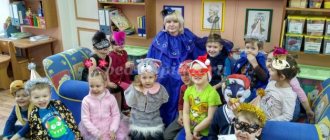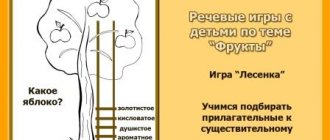Article:
Goal: to expand children’s ideas about the world of theater, about theatrical professions, to stimulate their interest in theatrical art, to enrich children’s vocabulary with theatrical terms.
Equipment: illustrations of the theater premises, theater poster, theater tickets, theater programs, slides with views of various theaters, photographs of actors, fragments of various performances, didactic game “Theater Professions,” dummies of vegetables and fruits, artificial flowers, attributes for the game “Barbershop.”
Educator: Do you know what theater is, what “theater art” means, what professions people work in the theater? (children’s answers).
Theater - the art of the stage - was born in ancient times. The word THEATER came to us from the Greek language and means “place for spectacle, spectacle.” But theater is not only an art form, but also a building where we come to performances.
Want to take a tour of the theater? (Illustrations of various theater buildings are exhibited).
Here is a house, big, beautiful, elegant, old. This is the theater building. Look, in front of him is a colorful, bright poster - a theater poster, which, using drawings, photographs and various words, contains information about upcoming performances in the theater (author of the play, director, actors who play the main roles, title, date and time of the performance). Let's go into this beautiful house. Where have we ended up? Look, we see a small window on which is written “Theater Box Office”.
Come to the window
Give him the money.
And a little window in response
Gives you a ticket.
A theater box office is a place where tickets for theater performances are sold. They contain the name of the theater, the name of the performance, its author, the date and beginning of the performance, as well as the place and row in the auditorium. A cashier sells tickets at the theater box office. Upon entering the theater, the ticket attendant checks the spectators' tickets. A theater performance usually takes a long time, more than an hour. It will be uncomfortable for spectators to sit in outerwear. What should I do? Where should viewers go first? (Children's answers). In the theater, the locker room is called a wardrobe, and the profession of the person who accepts the audience's outerwear is a cloakroom attendant. The cloakroom attendant gives you a number, you clean yourself up and move on.
Are you interested in knowing what today's performance will be about, what actors will play in it? Then you and I simply need to purchase a theater program from the theater employee, the usher. Look, it indicates the characters (heroes) of the play, as well as the names of the actors who play the roles of these characters. The program may also contain a brief description of the performance.
So, you and I are spectators. The performance will begin soon and it’s time for us to go to the auditorium. But what is it? Which of you is the most attentive and heard an unusual sound? This is a theatrical call. In total, the theater rings three bells before the start of the performance. The third bell indicates that the performance is beginning. After the third ring, the lights in the hall go out. It is indecent to enter the auditorium after the third bell. Before the third bell rings, let's take a closer look at the auditorium. This is the largest room of the theater. Take a closer look, do you like it? What makes an auditorium beautiful? (Walls, lamps, in the center of the ceiling there is a huge chandelier). Do you have chandeliers at home? Are they the same as this one? (Children's answers). This chandelier is very large, as the auditorium itself is huge. When the performance begins, this chandelier will go out, darkness will fall in the auditorium, and special spotlights will illuminate the stage. Soffits are special lamps in the auditorium that illuminate the stage from the front and above. With the help of spotlights, lighting designers can depict sunrise or sunset, flashes of lightning, starry skies and much more on stage.
Let's take our seats in the auditorium. How to do it? (See what is indicated on the ticket). The seat you should sit in is indicated on your theater ticket. Parterre - front, bottom rows, amphitheater - top, back. If you are sitting far from the stage, you will need theater binoculars, which you can bring with you or purchase from the cloakroom.
Let's take a look at our auditorium. The most important place in the auditorium is the stage on which the performance is performed. The scene itself is not yet visible. It is still closed with a curtain. A theater curtain is a piece of cloth that covers the stage from the audience. Curtains are made of thick, dyed fabric, folded and decorated with theater emblems or wide fringe sewn to the bottom of the curtain. The performance will begin as soon as the curtain rises or moves apart, as they are sliding or rising.
Many performances in theaters are accompanied by music. Where do you think the musicians sit, is it really on the stage? (Children's answers). The orchestra pit is a special room for the orchestra in the theater, located in front of the stage.
Before the audience can see the performance, people of different professions prepare it for a long time. Let's list them and try not to forget anyone! (Theater professions)
• The scenery for the performance is made in the painting and decoration workshop according to the sketches of the decorative artists.
• Prop - fake, specially made objects of sculpture, furniture, dishes, used in theatrical performances instead of real things. A theater worker who makes props is called a prop maker.
(The teacher shows the children fake things as examples: dummies of vegetables and fruits, artificial flowers, etc.).
• The sound for the performance - the phonogram - is prepared by the sound engineer. During the performance, he can turn on any soundtrack: the sound of rain or the roar of waves, the roar of the crowd or the whistle of the wind.
• Actors for a performance may need a variety of costumes: ancient and modern, fairy-tale and ordinary. The profession of a person who sews and makes suits is called a “costumer.”
• Before the performance, the make-up artist applies makeup to the actors. An experienced make-up artist can change an actor's face beyond recognition.
• The director chooses which play to stage, assigns roles, organizes and conducts rehearsals and everything that happens on stage.
• An actor is a person who plays a role in a play.
• A person who monitors the progress of the performance, the performance of the actors, and can, if necessary, suggest the words of the role to the actors - a prompter.
• A person who leads (conducts) an orchestra of musicians is called a conductor.
A didactic game “Theater Professions” is being held
Today our performance is on stage for the first time, so today is the premiere of this performance. So, the first act (part) of the play began.
(Children are invited to look at the illustrations of any children's performance or watch a video).
Are you tired, do you like our performance? The actors play wonderfully! Do you think they need to rest and prepare for the continuation of the performance?
(Children's answers)
The break between the actions of the play is called intermission. During intermission, all spectators usually go out into the theater foyer. At this time, you can go to the buffet, clean up in the toilet room, and also get acquainted with various photographs of theater artists that are hung on the walls of the foyer.
(Children look at photographs of Perm theater artists and excerpts from the performances in which they played).
Our performance has come to an end. Did you like him? How can we express this without words? Should I thank the actors for their wonderful performance? That's right, applause! Applause is a form of expressing gratitude to artists. If you liked the acting, give it a round of applause! You can also give them flowers.
Educator: We learned a lot of interesting things about the theater today. But there is a special place in it, which is called the mysterious word “backstage” - what is behind the stage. Today we were allowed to visit there with you. You can find a lot of interesting things here. The audience does not see this space. The actors and employees of the theater have their own entrance from the street, leading directly to the stage. Let's get acquainted with the premises of the “backstage kingdom”.
(The teacher lists these rooms and explains their purpose: decorator and props workshop, costume room, actors’ dressing room).
Educator: let us go into one of these rooms. Look, a table! Is he wearing a mirror, paints, powder, makeup, wigs? What kind of room is this? (Children's answers). That's right, this is the actors' dressing room. Let's now play actors and make-up artists, make princesses out of girls, and grandfathers out of boys.
(Children distribute the roles of make-up artists and actors among themselves and the transformations begin before everyone’s eyes)
The children then “return” back to kindergarten.
Summarizing:
Educator: What new did you learn? What surprised you the most? What did you remember? What new words did you meet, etc.
A series of conversations about theater with older preschoolers. Material (senior group) on the topic
A series of conversations about theater with older preschoolers.
Goal: To introduce preschoolers to the world of theater, to the specific rules of behavior in the theater, to stimulate their interest in theatrical art.
Conversation 1 “What is theater?”
Educator: Do you know what a performance is? What does "theater art" mean? Who are the authors? What kind of performances are there in the theater? What kind of scenery is there? Lighting? Transformations? Listen, now I will explain everything to you in order. (I post a photo of the Bolshoi Theater). Here is the house. From the outside, it looks like nothing special. Well, the house is just like a house, only more elegant than others, and there are fewer windows than doors. We entered and saw a window with the inscription “Box Office”. People buy tickets here. (The music director approaches the table decorated in the form of a cash register).” “Please give us tickets,” you say to the cashier, “for today’s performance.” “Please,” he answers you and tears off the tickets, on which are printed the name of the theater, the row number, and the place where you need to sit. You pay money. You get a ticket and go watch the show.
You buy a program from the theater employee, the usher. The program is a piece of paper on which everything you are interested in knowing about the performance before it starts is written: which actors are playing, what the name of the play is, who wrote it, and more.
A very interesting performance today! Let's take a look at today's program. Bah! Yes, this is the Petrushkin Theater, where they perform the fairy tale “Oh, Turnip!”
Let's buy tickets to the show. Who will be our cashier? Children “buy” tickets and sit down to watch any fairy tale prepared by the music director.
Conversation 2 “Who invented the theater?”
Educator: Theater already existed among the ancient Greeks. They were the first to come up with the idea of presenting the legend about their gods and heroes in living persons. They realized how wonderful, instructive and entertaining a theatrical spectacle can be, where instead of the storyteller, the very people who are told about in the fairy tale appear before the audience. After all, we believe much more what happens in front of our eyes than what we are only told about. The Greeks discovered ways to present well in the theater both serious works - tragedies, and funny ones - comedies. When the actors portrayed different people, gods, animals, the audience very often rewarded them with clapping of their hands - applause.
In ancient times, actors played on the street. Almost the entire population of the city was present at the performance. To make the actors clearly visible, they wore large masks, much larger than their heads. And so that the public could hear clearly, a mouthpiece was inserted into the mouth of the mask, calling the person.
From the Greek theater we borrowed many of the names for our theater, starting with the word “theater” itself, which in Greek is pronounced “theatron” and means “spectacle”.
Let us now put on these masks and turn into different animals.
Now tell me, what animal is called the king of all animals?
That's right - a lion. The game is called "Animals, beware of the lion!"
A game similar to “Trap”. The lion is in the middle of the circle, the animals move in leaps to the music, then clap rhythmically and say: “One, two, three, well, quickly catch us!” and run away. "Lion" catches. The one who is caught takes his place, and so on.
Conversation 3 “In the theater”
Educator: At the last lesson, you and I saw the theater, went into it, bought a ticket and a program at the box office. Today I propose to go into the auditorium and look around. (Exhibits an illustration or diagram of the theater auditorium).
The most important place in the auditorium is the stage where the play is presented. And opposite the stage are rows of chairs and armchairs. Those seats that are closer to the stage are called an amphitheater. And on the sides there are boxes with beautiful names: benoir, mezzanine, balcony. Each box, that is, in a fenced-off area, can accommodate 4 or, if the box is large, 6 chairs. If you are sitting far from the stage, then you will need binoculars. This is a device consisting of two tubes with magnifying glasses to better see what interests you, but to be at a relatively far distance.
Now pay attention to the scene. See the light coming from the edge of the stage and illuminating the curtain. Here a row of light bulbs, called a ramp, is placed along the entire length of the stage. The stage itself is covered with a curtain. The performance begins as soon as the curtain rises, or moves apart, because there are two systems of curtains: rising and sliding.
Do you know the fairy tale “The Nutcracker”? No? Just today it will be presented in the theater. (The musical director includes a video recording of P.I. Tchaikovsky’s ballet “The Nutcracker”, where the auditorium of the Bolshoi Theater, stage, and curtain are clearly visible. Children listen to the overture of the ballet, watch the beginning of the performance).
Conversation 4. “Behind the Scenes”
Educator: Guys, you can find a lot of interesting things in the theater, let's see today who is hiding behind the scenes, that is, behind the stage. The audience does not see this space. The actors and employees of the theater have their own entrance from the street, leading directly to the stage. If we get there, then the most important person we will meet there is the theater director.
When the author writes a play and the theater accepts it for production, the first person to receive the play is the director. He carefully reads the play, studies it and discusses it with the actors. Then he distributes the roles between the actors - those words and those images that the actors should speak and portray on stage, reads the play to them and assigns rehearsals - an approximate performance of the play. While the actors are rehearsing the play, other work is in full swing in the neighboring rooms: the decorator paints the scenery for the play, the costume designer sews costumes for the actors. And then the day comes when the performance is performed for the first time. This is the premiere (in French - “first time”). Guys, where do you think the actors play? That's right, on stage. (Shows illustration). See how big it is? If we look up, we see many curtains. These are hanging decorations, and those decorations that are on the stage are called “pavilion”.
Having examined the stage, we can get acquainted with other rooms of the “backstage kingdom”: the decorator and prop maker’s workshop, the costume room, and the actor’s dressing room - where he puts on makeup and changes clothes.
Do you guys know who a prop man is? A props maker is a person who makes artificial things. (Show props, fruits, flowers for the reception).
And now we are in the actor's dressing room. Look! A table with a mirror on it, paints, powder, fake hair, which is called a wig. Here the actor turns into the hero of a fairy tale. And theater make-up artists and hairdressers help him with this.
Let's now play actors and make-up artists, make a princess out of an ordinary girl, and a grandfather out of an ordinary boy.
They choose one make-up artist and two actors, and they begin their transformations in front of everyone.







